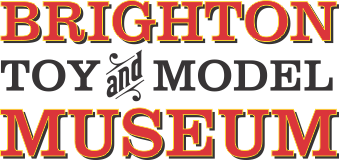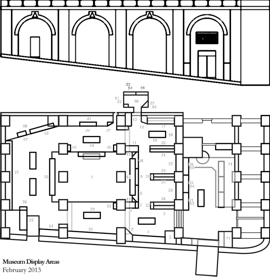Category:W. Britain: Difference between revisions
m (→References: Ooh, and if it's a book, you can add the ISBN number, and MediaWiki automatically generates links to external sites that might have it. The 10-digit version of ISBN is usually fine.) |
BTMM Gillian (talk | contribs) No edit summary |
||
| Line 1: | Line 1: | ||
{{Toymaker}} | {{Toymaker}} | ||
'''William Britain Senior''' began his career as a 'Brass Cock Maker', but | '''William Britain Senior''' began his career as a 'Brass Cock Maker', but production of toy soldiers - which was to make William Britain a household name - began in 1893, using the hollowcasting process. | ||
At the time, imports from Germany dominated the toy market. However, despite this, Britains continued to grow, with production only slowing/stopping during the First and Second World Wars. Until the late 1950’s, very little changed in the style of the figures, but production of metal hollowcast figures ceased in 1966 due to with the introduction of plastic figures from companies such as Herald. From 1966 until the early 1980s, Britains continued to focus on space and agricultural toys as well as plastic military figures. In 1983, Britains produced its first all metal figure in nearly 20 years. Despite the fact that a diecast metal Scots Guard figure set was launched in 1973, these featured plastic weapons so could not be classified as true metal models. These first few sets featured typical ceremonial subjects such as Life Guards, Black Watch and Yeomen. These proved to be so popular that by 1984 the “Metal Models” range had begun to grow. | |||
In 1984, Dennis Britain wished to retire, and no other family shareholder wished to take over the company. It was therefore sold to a small Midlands-based conglomerate, '''The Dobson Park Group''', who changed the company name to '''Britain Petite Ltd''' in 1986.'Metal Models' continued to appear in the main Britains catalogue during the 1980s until 1987 when it was decided that these lines were collectibles rather than toys. They were therefore given their own special four-page catalogue, and during the late 80s the popularity of these figures continued to grow. In 1993, the '''W. Britain Centenary''', the W. Britain Collectors Club was launched, and still exists today, with thousands of members all over the world. | In 1984, Dennis Britain wished to retire, and no other family shareholder wished to take over the company. It was therefore sold to a small Midlands-based conglomerate, '''The Dobson Park Group''', who changed the company name to '''Britain Petite Ltd''' in 1986.'Metal Models' continued to appear in the main Britains catalogue during the 1980s until 1987 when it was decided that these lines were collectibles rather than toys. They were therefore given their own special four-page catalogue, and during the late 80s the popularity of these figures continued to grow. In 1993, the '''W. Britain Centenary''', the W. Britain Collectors Club was launched, and still exists today, with thousands of members all over the world. | ||
==The Hollowcasting Process== | ==The Hollowcasting Process== | ||
Revision as of 14:29, 1 February 2012
| Toy Brands and Manufacturers |
|---|
W. Britain |
William Britain Senior began his career as a 'Brass Cock Maker', but production of toy soldiers - which was to make William Britain a household name - began in 1893, using the hollowcasting process.
At the time, imports from Germany dominated the toy market. However, despite this, Britains continued to grow, with production only slowing/stopping during the First and Second World Wars. Until the late 1950’s, very little changed in the style of the figures, but production of metal hollowcast figures ceased in 1966 due to with the introduction of plastic figures from companies such as Herald. From 1966 until the early 1980s, Britains continued to focus on space and agricultural toys as well as plastic military figures. In 1983, Britains produced its first all metal figure in nearly 20 years. Despite the fact that a diecast metal Scots Guard figure set was launched in 1973, these featured plastic weapons so could not be classified as true metal models. These first few sets featured typical ceremonial subjects such as Life Guards, Black Watch and Yeomen. These proved to be so popular that by 1984 the “Metal Models” range had begun to grow.
In 1984, Dennis Britain wished to retire, and no other family shareholder wished to take over the company. It was therefore sold to a small Midlands-based conglomerate, The Dobson Park Group, who changed the company name to Britain Petite Ltd in 1986.'Metal Models' continued to appear in the main Britains catalogue during the 1980s until 1987 when it was decided that these lines were collectibles rather than toys. They were therefore given their own special four-page catalogue, and during the late 80s the popularity of these figures continued to grow. In 1993, the W. Britain Centenary, the W. Britain Collectors Club was launched, and still exists today, with thousands of members all over the world.
The Hollowcasting Process
Hollowcasting was the process where molten lead was poured into a figure mould, and some of the molten metal was poured back out again before the entire figure could set. The result of this process was that the Lead would form the skin on the inside of the mould, but by pouring the molten lead back out again, the figure would be hollow in the centre. In spite of the fact that German figures have been discovered, predating 1893, which appear to be hollow, it was W. Britain who pushed the process into the mainstream. Given that each figure contained less metal, W. Britain were able to achieve a lower retail price, and could thus compete with the German figures of that period.
Following Cultural Trends
While Britains is mostly famous for the company's work on military themed figures, the civilian side of life has not been fully ignored. Before the death of W Britain himself in 1906, this was very much a minor side of the company, with figures based on contempary football teams being the main exception to the military rule ... however his son slowly started branching out more by producing lines based on the Salvation Army, the Boy Scouts and Railway figures.
The aftermath of World War One, however, changed things considerably, as public sentiment was less receptive to children's playthings with violent trappings. Wise enough not to sail against the wind of popular opinion, Britains began to massively increase their production of lines focused more on civilian life. In 1923 the Model Home Farm series was introduced and served as a springboard for the development of other lines, by 1940 the catalogue included sets based on Zoos, Gardens, Police, Circuses, Hunting figures, Ambulances, Trucks, Mail vans, Roadsigns and Horse racing. However it wasn't until World War Two that Britains released their "Lilliput" which was set to 00-gauge scale to be compatible with model train sets - until this point ALL the company's models were produced to the scale associated with military figures.
References
- W. Britain - The History (wbritain.com)
- A Short History of Britains Toy Company (gibbs.fastfreenet.com)
- Gordon Gardiner, and Alistair Morris, The All-Colour Directory of Metal Toys: A Pictorial Guide to the Art of Collecting International Playthings (Salamander Books Ltd, 1984) ISBN 0701818263
This category currently contains no pages or media.


